ASUS P7P55D EVO - Picture Preview
by Gary Key on July 9, 2009 12:15 AM EST- Posted in
- Gary's First Looks
Ahhh…. summer is upon us and so is a new Intel product release in the near future. The Lynnfield processor series and P55 chipset will be arriving in the next couple of months. As such, we are already receiving various P55 motherboard samples from a variety of companies for early first looks and opinions. We really do not have anything new to report on Lynnfield and P55 since our early preview, except that final silicon spins will be ready by the end of this week according to various sources.
ASUS has delivered one of the first P55 boards to our labs and granted us permission to provide an early look at it as long as performance numbers were not generated and we kept the BIOS options private. We know, this will be about as fun as playing with a stack of wet blankets on a cold day, but at least we can start the process of providing first looks at products that will be on sale shortly.
The first motherboard of many to come is the ASUS P7P55D EVO that is destined for the mid-range of ASUS’ extensive P55 lineup that covers every market sector from entry level to the enthusiast level ROG boards. Final pricing is not yet available but based on chipset pricing and market conditions, expect to see P55 boards starting around $120 and rapidly hitting the $239 mark at launch. This particular motherboard will probably end up in the $160~$180 sector based on the feature set and options.
Before we get to the board layout and options, we need to state that this color scheme is not the final design based on conversations with ASUS today. However, the layout/features checklist is final and any comments you might have about those two areas are welcome. We should have a press photo of the final color scheme shortly, but it features an all black and dark blue color palette. This is good news as we had more than a few choice words with ASUS over the holiday weekend after we opened the box.
Board Layout
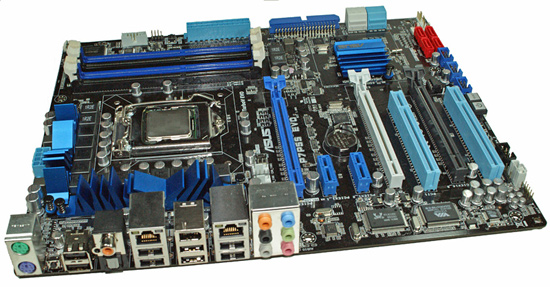
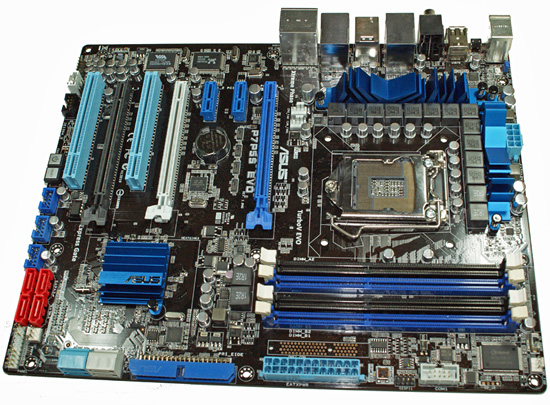
Taking a quick look around this board, we find the overall layout is very good but could be better. The good, ASUS placed the 24-pin and 8-pin ATX power connectors, IDE connector, and most of the SATA ports along the edge of the motherboard. In addition, the PCIe/PCI slot layout is very good for those seeking many expansion slots or planning on SLI/CF operation.
The bad, we just do not care for the SATA slot arrangement and where the IDE connector is located, or even the fact that IDE is still on the board. We would rather see all of the SATA connectors grouped (right angle design) together where the current IDE connector is located. This might seem contradictory to our good listing, but if ASUS had to go with IDE, at least the layout is serviceable at this time.
ASUS also includes Power and Reset switches on the edge of the board. Another user friendly feature is the inclusion of debug LED (red lights) to indicate potential problems with the CPU, DRAM, VGA, or Boot devices at time of POST or if the board locks on the user.
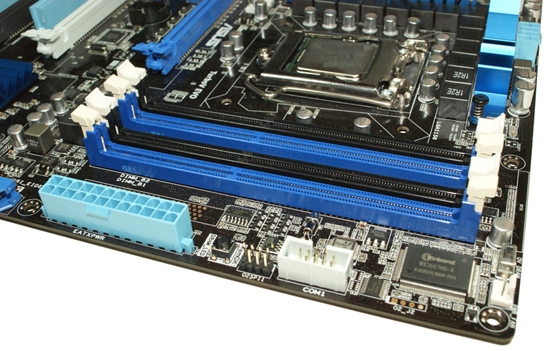
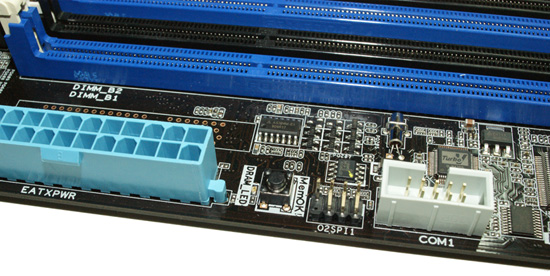
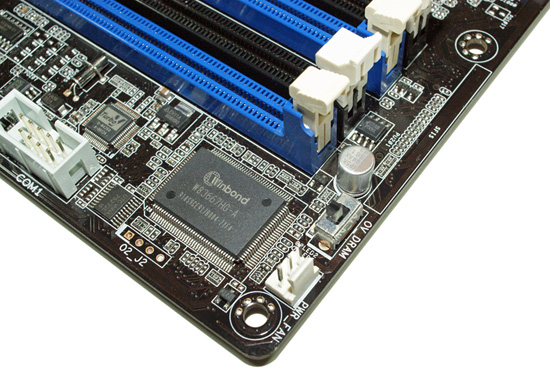
There are quite a few features located in the memory slot area. First off, the memory slots will receive the single clip insertion design from the current ROG i7 boards as it is nearly impossible to change memory modules with a video card installed. ASUS continues to offer their MemOK! technology that will reset the memory timings to safe values in case the user settings are too aggressive causing the system not to POST. While it sounds impressive, we have yet to need it as the BIOS recovery system will typically kick in and reset the board to stock values correctly. The OV DRAM switch lets you override the BIOS limits on VDimm, which are already more than high enough to void warranties or damage your CPU.
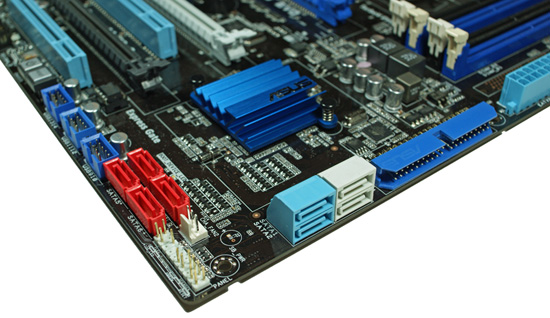
Our least favorite area of the board contains the six SATA 3Gb/s ports provided by the P55 chipset that feature RAID 0, 1, 5, and 10 support along with Intel’s new version 9 Matrix Storage technology. The two white SATA connectors are powered by the new Marvell 88SE9123 6Gb/s SATA chipset that unfortunately is not ready for prime time yet due to continuing driver and hardware problems. We expect this controller to be pulled from the board if the problems persist. The IDE connector (driven by the Marvell controller), P55 chipset, front panel connectors, and the three USB headers are also located in this area.

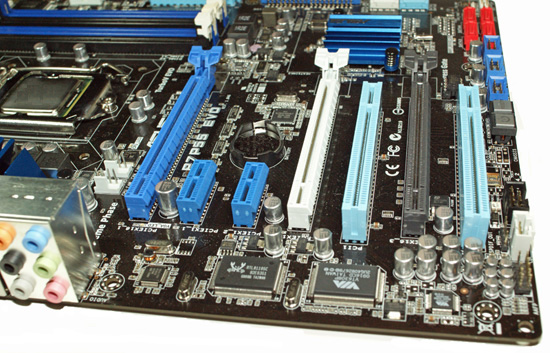
The board features two PCIe 2.0 x1 slots, two PCI slots, and three PCIe 2.0 x16 slots (x16/x4 or x8/x8/x4). The x4 PCIe slot is provided by the P55 chipset and is not designed for optimal graphic’s performance. In fact, NVIDIA has pulled SLI support for this slot and we expect AMD to do the same for CrossFire due to performance reasons. The layout of the PCI/PCIe slots is very good and allows for a single PCIe x1, PCIe x4, and PCI slot when running SLI or CrossFire.
ASUS utilizes the VIA VT6308P chipset for IEEE 1394a support, VIA VT1828S 8-channel HD audio codec with support for DTS Surround Sensation, and the Realtek 8112L/8110SC Gigabit LAN controllers for LAN operation including support for AI NET2. Why manufacturers will not utilize the native Intel Gigabit LAN support in the P55 is beyond us. The VIA VT1828S actually provides decent onboard audio support with better output quality than the standard Realtek ALC888 series. However, the Win7 drivers are still not working properly so our initial results were with Vista 64.
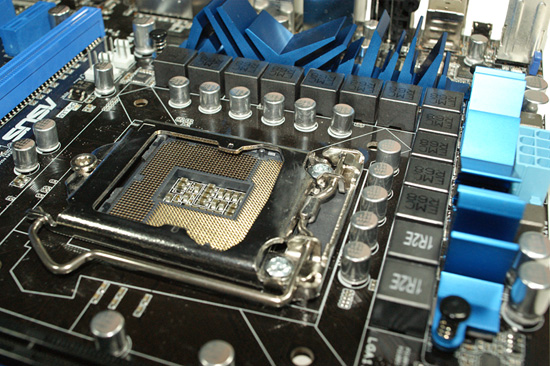
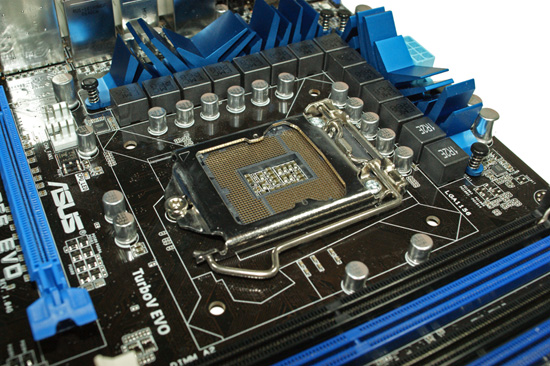
The CPU area is uncluttered and a push/pull CPU fan/heatsink design like the Vigor Monsoon III will interfere with memory in the first dimm slot, unless the mounting design on the cooler is changed. The back of the board is clean and we expect various air/water coolers that require a back plate to work fine. What we would like to see is Socket 775 mounting holes on this board as an option as yet another socket change is wearing thin on us. ASUS is utilizing a 12-phase power system that has allowed easy 230+ Bclk rates in early testing.
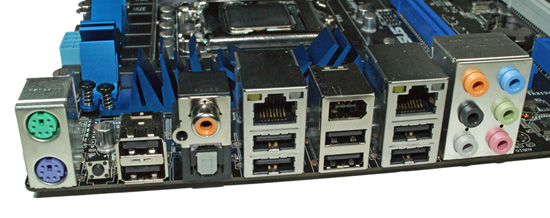
The rear panel features the standard PS/2 mouse and keyboard ports, optical/coaxial SPDIF out ports, eight USB 2.0 ports (total of 14 available on the board), dual Gigabit LAN ports, IEEE 1394a port, audio panel, and a handy Clear CMOS switch.
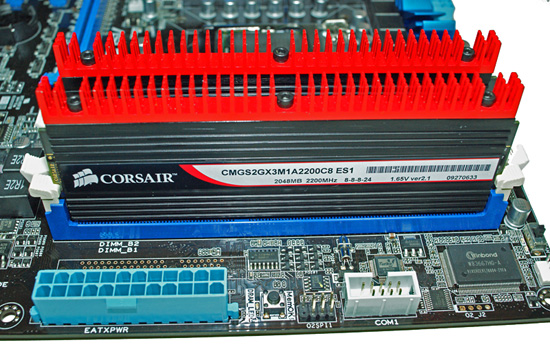
We have been testing this board with the Corsair DDR3-2200 C8 memory kit. Yes, these modules feature the Elpida Hyper ICs that have been giving us trouble in the labs but so far, these particular modules have behaved themselves.
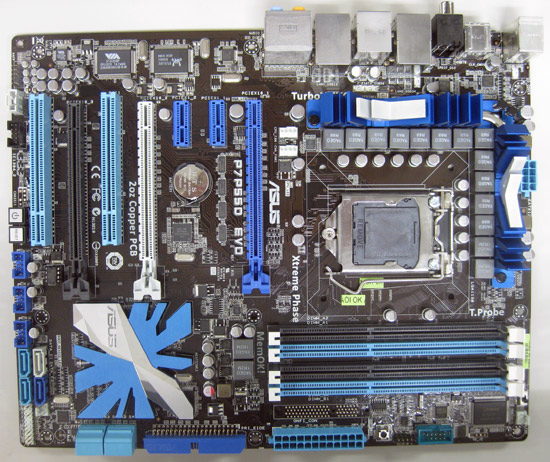
Update - This is a picture from ASUS tonight of the final production board design and color scheme. The revised heatsink designs certainly have an artistic flair about them. Otherwise the new color scheme is not bad at all, although the light blue tends to make us think of Gigabyte's recent boards.
















57 Comments
View All Comments
Hrel - Thursday, July 23, 2009 - link
I like the color scheme; Deeper blue's, darker black's and maybe a little yellow thrown in there. That's all I could really think to change.Specifically, all the IDE and SATA ports should be red and the Memory slots should be Blue and Yellow with the main board being all black. You could play with yellow and blue on the PCE(e) ports as well.
marraco - Wednesday, July 15, 2009 - link
I would love to buy a mother with a PCI/PCI-e card to hold my old discarded Core 2 / X2 and DDR2 as 2 extra cores...A mother with support for it would be invaluable.
Konstantineb - Saturday, July 11, 2009 - link
Placing the shitty P6T Delux V1 over the Gigabyte EX58 UD5 board was biased and out of reason. The malfunctioning Load-Line calibration feature claim was BS.According to xbitlabs, the board has a better overclocking potential than the Asus one, and is more power saving than the Asus one, and has the ACC functioning without a problem.coconutboy - Wednesday, July 15, 2009 - link
Wait, lemme get this straight. You're claiming Anandtech is biased against Gigabyte despite a Gigabyte board receiving an Editor's Choice award? Really? Nevermind that the review in question was from early Dec comparing brand new x58 boards (which were still somewhat buggy at the time) or that plenty of products from manufacturers A through Z get kudos on this site. I also notice there's a Gigabyte mobo on the frontpage right now getting praise even though it's an early preview. Quote from the preview, "Gigabyte has produced yet another sterling uATX motherboard that is fully featured."Sounds like you're the one who is biased. Xbit is a great site and I've been frequenting it for around a decade, but there are tons of hardware sites out there. Anandtech and xbit are just two of many, and IMO both do a great job of attempting to be impartial despite manufacturer influences. Maybe you can try to do the same in your posting instead of coming off like a butthurt fanboi upset his mobo of choice didn't win the gold.
swaaye - Friday, July 10, 2009 - link
I too would really like to know why they ignore the Intel NIC. Is it a gimped solution worse than these Realtek chips? The Realtek NICs have had decent offload for quite a while now, and in my experience they do move the data quite speedily, so maybe they're actually better than Intel's budget integrated stuff?Stele - Monday, July 13, 2009 - link
Along with what Gary Key remarked:"Why manufacturers will not utilize the native Intel Gigabit LAN support in the P55 is beyond us."
Actually I suspect that the Intel ones may have better performance and/or stability. Nevertheless, it's very likely due to one word: cost.
Intel being Intel, iirc the integrated MAC cannot interface with any Tom, Dick and Harry of a PHY, but requires the proprietary LCI/GLCI interface which is used by only certain Intel PHYs - "Gigabit LAN Connects" in Intel's parlance, such as the i82567 found on Intel's own motherboards.
The cost factor extends beyond just these proprietary PHYs required. Due to the proprietary interface used, these PHYs can only be used on Intel chipset boards. What of the non-Intel chipset ones? Nvidia, AMD etc... purchasing, control and inventory costs would go up if motherboard manufacturers had to keep separate inventories of PHYs and/or NICs for each platform.
Or they could just use external NICs all the way for all their products, as they do now. That would also ease design costs in terms of resources, time and effort since they've lots of experience with the external NICs and can practically design them in with their eyes closed.
So all in all, it was likely a business decision to go with external NICs than to tap the ICH MAC on Intel chipsets.
Stele - Monday, July 13, 2009 - link
p.s. Here's something interesting from the ICH10 family datasheet:"The Gigabit Ethernet controller has a PCI interface to the host processor and host memory" (section 5.3.1, p.102, doc.319973-003)
I wonder if that statement means what it seems to... any reviews of network performance for motherboards using the ICH MAC? If it's true, then so much for all the hue and cry when motherboard manufacturers use PCI GbE controllers instead of PCIe ones - which might well be easier to source and cost less than the requisite Intel LCI/GLCI PHY. :P
Etern205 - Friday, July 10, 2009 - link
Looking closely at those pics, just notices are they two different boards?In one of the boards near the ram slot it says Xtreme Phase and the other says Turbo EVO.
Anyway I hope Asus does not label enthusiasts as ricers by putting a bunch of damn goofy terms on their final product.
2oz cooper PCB, Xtreme Phase, Tubro Evo, and T-Probe?!
lol
GeorgeH - Friday, July 10, 2009 - link
Same board; different revision/color scheme.geok1ng - Friday, July 10, 2009 - link
I build my PCs since 1996, and i have NERVER felt the need for a serial port with RS232 until yesterday , when the firmware of my set top box went nuts , the remote control went silent and it is now simply impossible to update the firmware without a null modem cable and RS232. The catch is that my P5Q Deluxe has no serial port.For lower power consumption and better overcloking potential i think that removing all rare/legacy hardware support is the easy way to go. All we need is a bundle of PCI adapters for all of this crap connnector. maybe an smart engineer will come with a single PCI device that features serial, IDE, PS2, Firewire and floppy connectors. That would save a LOT of motherboard space!